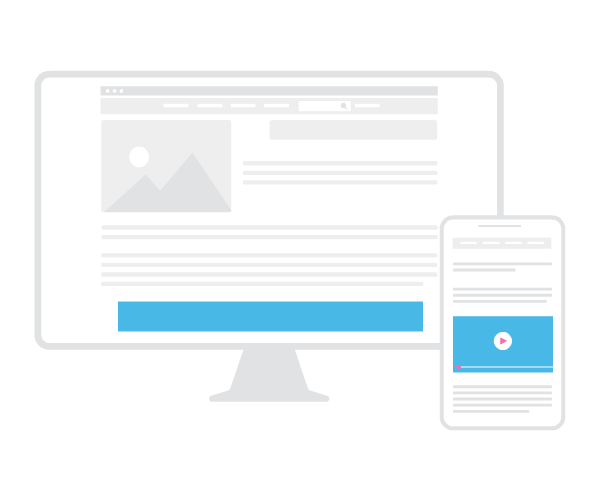OutStream Video
Outstream video ads are ads that appear in a video player within the body of your page content or article. The video ad does not precede video content.
For example, if you are a news publisher, you might have a text-based article that contains a video player between paragraphs. As the reader scrolls through the article, the outstream video ad is triggered and plays when they reach the previous paragraph. This video player collapses as the user scrolls away.
Technical specifications
- Dekstop / tablet / mobile: Min 640 x 360 / max 1920 x 1080
- Bitrate: 1,5 mbps
- Max. weight: 512 MB
- Extensions: .MOV/.MPEG/.AVI/.WMV/.MKV/WebM
- Max. ad length: 30 sec
- Skippable: No
Important
To ensure maximum ad quality on both mobile and desktop devices, we ask you to provide two ad formats: one for mobile devices and one for desktop
Many newer devices use high-density displays with twice as many pixels as older devices resulting in higher resolution images and a better end-user experience. For images (jpg/png/gif), the retina sizes are optional if we receive the mobile (standard) format.
- All active HTTPS 3rd party tags are accepted.
- All assets loaded by the 3rd party tag must be HTTPS as well.
We strongly recommend the use of HTML5 but under the following conditions:
- CSS selector must contain banner specific prefix’s.
- Must contain an IAB ClickTag and open the landing page in a new tab.(See following pages for extra information.)
Max 2.5mb, Up to 30 seconds, Longer than 30 seconds during user interaction. play, pause, stop, sound on/off button must be present.
Due to iOS video behaviour, following parameters must be added to the HTML5 video tag: playsinline=”playsinline” webkit-playsinline=”webkit-playsinline”
Standard audio off, only on with user interaction, on mouse off the creative, audio should stop. Sound on/off button must be present.
- Maximum 3 loops within 15 seconds
- No loop or animation after 15 seconds
- ImpressionTracker: to measure the number of impressions.
- Clicktracker: to measure the number of clicks.
Destination URL, impression trackers and click trackers must be delivered in the same e-mail as the material, in a text file.
- If you are supplying a 3rd party script, you must ensure that the ‘expanded unit’ uses the following Z-index:
– Expandable ad blocks: 9999
– Floting ad blocks (overlay): 100000
– Takeover: maximum 350
We accept:
- HTML5 ads in the form of .zip file or 3rd party script
for Classical or Responsive TakeOvers HTML5 only possible if served via 3rd party script - Images: .gif / .png or .jpg files are accepted
We do not accept:
- HTML5 files for newsletters.
Practical tips for clicktag implementation
Normal implementation: https://support.google.com/admanager/answer/7046799
Google Web designer implementation: https://support.google.com/webdesigner/answer/3263494?hl=en
When delivering 3rd party tags which generate an iframe, though it is not required we recommend the use of responsive banners.
Delivery
All material should be sent to digitaladvertising@adsanddata.be.
- Standard: 3 business days before the start of the campaign.
- Rich media: 5 business days before the start of the campaign.
These deadlines have been set to ensure that your campaign starts on schedule.
- All necessary creatives.
- Active destination URL’s.
- If applicable, detailed instructions on how material should run.
- Will be given within 24 hours after reception.
- If material does not meet requirements, procedure will restart.
- The .zip file must contain at least one index.htm or index.html file, or another unique .htm or .html file. This file will be used as the starting point for the HTML5 advertisement.The main .html file contains a clickTAG. Our ad server counts on it to correctly track the clicks.
- Normal implementation: https://support.google.com/admanager/answer/7046799
- Google Web designer implementation: https://support.google.com/webdesigner/answer/3263494?hl=en
- The main .html file refers relatively to all code and assets. This means that all links in HTML5-creative, like the link to an image in the ad, have to use a relative path, for example /graphics/ad-image.png or <img src=”/graphics/ad-image.png”>. In this way, the ad can be independent and therefore run or be displayed independently without a network connection. External libraries and web fonts may constitute an exception to thisto this guideline.
- There are no specific rules for the folder structure in the .zip file. All files can be organized in different subfolders or in the root folder.
- The number of files should be kept to a minimum (maximum 15)because each other file leads to a separate request, which affects the performance of the web page on which the ad is loaded.
- If you are linking to external libraries (jquery, etc.), ensure the request is made via HTTPS (SSL). x Send all HTML5 .zip files through a service like WeTransfer or Dropbox
